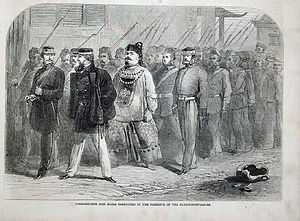Battle of Canton (1857)
| Battle of Canton | |||||||
|---|---|---|---|---|---|---|---|
| Part of the Second Opium War | |||||||
 The British capture of Ye Mingchen on 5 January 1858 | |||||||
| |||||||
| Belligerents | |||||||
|
|
| ||||||
| Commanders and leaders | |||||||
|
|
| ||||||
| Strength | |||||||
| 5,679[1] | 30,000[1] | ||||||
| Casualties and losses | |||||||
|
15 killed, 113 wounded[2] | 200–650 casualties (est.)[3][4] | ||||||
The Battle of Canton was fought by British and French forces against China on 28–31 December 1857 during the Second Opium War. The British High Commissioner, Lord Elgin, was keen to take the town as a demonstration of power and to capture Chinese official Ye Mingchen who had resisted British attempts to implement the 1842 Treaty of Nanking. Elgin ordered an Anglo-French force to take the town and an assault began on 28 December. Allied forces took control of the city walls on 29 December but delayed entry into the city itself until 5 January. They subsequently captured Ye and some reports state they burnt down much of the town. The ease with which the allies won the battle was one of the reasons for the signing of the Treaty of Tientsin in 1858.
Prelude
The British were keen to capture the town of Canton as a symbol of their power and to capture Ye Mingchen, a key figure in Chinese resistance against foreign forces.[4] Although the British Royal Navy had destroyed the Chinese junks during the summer, an attack on Canton was delayed by the Indian Mutiny.[5] On 12 December 1857 the British High Commissioner to China, Lord Elgin, wrote to Ye demanding that he implement in full the trade and access agreements made in the Treaty of Nanking that ended the First Opium War and that he pay reparations for British losses in the war so far. Elgin promised that if Ye agreed within ten days then British and French forces would cease offensive actions, though they would retain possession of key forts until a new peace treaty was signed.[4]
Ye's reply was that Britain had effectively abandoned its rights with regards to Canton through eight years of inactivity, that the cause of the war (the loss of the merchant ship Arrow) had been of the British making and that he could not sign a new peace treaty because the 1842 treaty had been decreed by the emperor to last for 10,000 years. Elgin boarded HMS Furious on 17 December and sailed upriver towards Canton. On 21 December he ordered British Admiral Michael Seymour, French Admiral Charles Rigault de Genouilly and British General Charles van Straubenzee to take Canton and handed over full operational control.[4]
British and French troops reconnoitred the city on 22 December.[6] The allied force amounted to 800 men from the Indian Royal Sappers and Miners and the British 59th (2nd Nottinghamshire) Regiment of Foot, 2,100 Royal Marines, a 1,829-man naval brigade drawn from the crews of British ships and a 950-man force from the French Navy arrayed against a Chinese garrison of 30,000 men.[4][5][6] However the allies could count on the supporting fire of Anglo-French naval vessels and an artillery battery on Dutch Folly and other nearby islands.[4]
Battle

The battle began with a naval bombardment on 28 December and the capture of Lin's Fort one mile inland,[4] and the next day troops landed by Kupar Creek to the south-east of the city.[6] The Chinese had thought that the attacking forces would try to capture Magazine Hill before they moved on the city walls, but on the morning on 29 December after a naval bombardment ending at 9am French troops climbed the walls with little resistance. They had arrived at the wall half an hour early and so faced fired from their own guns.[4] Over 4700 British and Indian troops and 950 French troops scaled the city walls[5] The walls were occupied for a week, then the troops moved into the streets of the city on the morning of 5 January.[6] Some reports estimate tens of thousands of Chinese were killed or captured and nearly 30,000 homes were burned down, although other sources put Chinese casualties at 450 soldiers and 200 civilians.[7][4] British losses amounted to 10 sailors and three soldiers killed and 46 sailors, 19 marines and 18 soldiers wounded.[2] French losses were two sailors killed and 30 wounded.[2]
Aftermath

Commissioner Ye Mingchen was captured and taken to Calcutta where he died a year later.[4] Once the British and French had occupied the city they established a joint governing commission.[8] Partly due to the battle and subsequent occupation – the Chinese wanted to avoid a repeat of the battle in Beijing – the Treaty of Tientsin was signed on 26 June 1858, ending the Second Opium War.[8][7]
| Wikimedia Commons has media related to Battle of Canton (1856–1858). |
References
- ↑ 1.0 1.1 The London Gazette: p. 1021. 26 February 1858. Issue 22104.
- ↑ 2.0 2.1 2.2 The London Gazette: p. 1026. 26 February 1858. Issue 22104.
- ↑ Cooke, George Wingrove (1858). China: Being "The Times" Special Correspondence from China in the Years 1857–58. p. 357.
- ↑ 4.0 4.1 4.2 4.3 4.4 4.5 4.6 4.7 4.8 4.9 Elleman, Bruce A. (2008). Naval coalition warfare: from the Napoleonic War to Operation Iraqi Freedom. Routledge. ISBN 0-415-77082-3.
- ↑ 5.0 5.1 5.2 Raugh, Harold E. (2004). The Victorians at war, 1815–1914: an encyclopedia of British military history. ABC-CLIO. p. 100. ISBN 1-57607-925-2.
- ↑ 6.0 6.1 6.2 6.3 Carter, Thomas (1861). "Capture of Canton". Medals of the British Army, and how they were won 3. Groombridge and sons. p. 186.
- ↑ 7.0 7.1 Santella, Thomas M. (2007). Opium. Infobase Publishing. pp. 32–33. ISBN 0-7910-8547-3.
- ↑ 8.0 8.1 Harris, David (1999). Of battle and beauty: Felice Beato's photographs of China. University of California Press. p. 16. ISBN 0-89951-100-7.